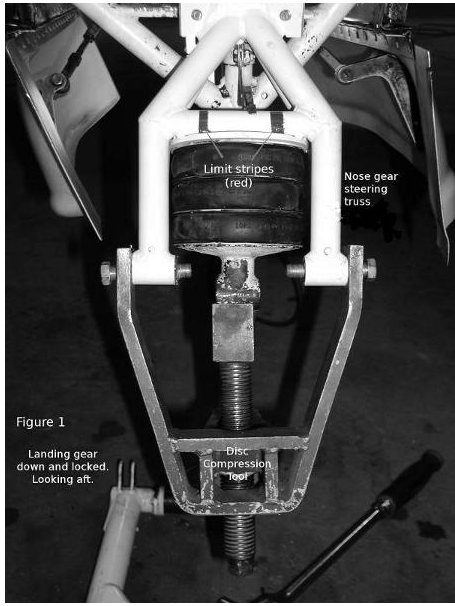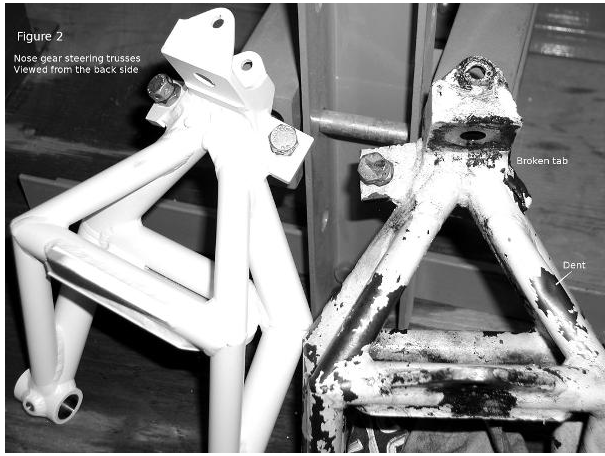TOW SORROW
August 2013
This month's Shop Talk will show the Mooney owner how to inspect their aircraft after it has been towed using a tow bar that steers the nose wheel under power.
This simple inspection is important to add to your existing preflight (and immediately after a tow) inspection as it may save you an expense of $1,800 or more to replace a damaged or dented nose gear steering truss (leg).
First a little history: In the late 1970s, Mooney redesigned their nose gear steering truss by adding adjustable rudder stops. The stops were also added to the replacement truss for older (pre-1970) Mooneys.
When Mooney added these stops they were named rudder travel stops, not steering stops, even though they would now physically stop the steering truss from turning (left or right) beyond the limits established by the original rudder stops installed in the tail cone. The original rudder stops are installed in the tail cone and consist of two metal bars riveted vertically that make contact with two adjustable clamps installed on the rudder push-pull tubes.
 Rudder travel limits are set by placing the plane on jacks so the nose wheel is free. A rudder travel board is used to establish the degree of maximum rudder displacement. The nose gear steering truss has adjustable bolts with safety wire holes and jamb nuts. These bolts are adjusted to be the limiting factor for the rudder travel limits. The two adjustable clamps in the tail are checked to insure that they are not limiting.
Rudder travel limits are set by placing the plane on jacks so the nose wheel is free. A rudder travel board is used to establish the degree of maximum rudder displacement. The nose gear steering truss has adjustable bolts with safety wire holes and jamb nuts. These bolts are adjusted to be the limiting factor for the rudder travel limits. The two adjustable clamps in the tail are checked to insure that they are not limiting.
Mooneys are not known for their tight turning radius and when these stops were added to the nose gear steering truss the turning radius became more critical during towing with a tug and tow bar. Adding to this problem, the steering limits placard or paint is difficult to see, especially on aircraft with longer noses. (Some of these placards have been out of stock for some time.) This and an inattentive tug operator can lead to a dented or broken nose gear steering truss.
Mooney allows up to a 1/32 inch dent in the vertical (aft) tubes of this truss. In practical terms that means if you can feel a dent in the tube it's probably not airworthy and might need to be replaced.
Currently the list price for a new nose gear steering truss #940042-503 or 505 is over $2,500! A rebuilt one can be purchased for around a $1,000. Twenty years ago a number of suppliers could offer you a rebuilt nose gear steering truss, but today you will need to call the good folks at Lake Aero in Lakeport, California to get one.
Typically when I see a dented or damaged nose gear steering truss, and I still see them, the entire nose gear will have to be removed to replace the nose gear steering truss.
As one can imagine this is an all-day affair with the plane on jacks. The nose gear rubber shock discs and steering horn will have to be removed. A special disc compression tool is used to remove the disks (the tool attached to the truss in Figure 1).
With our planes getting older, it is not uncommon to find the steering horn in need of re-shimming or the shock discs in need of replacement. These items can add hundreds of dollars to the cost of this repair. Eight hours on jacks is not uncommon, and at $80 per hour you now have a $640 labor bill to go with your $1,000 rebuilt nose gear steering truss. Assuming you did not need any other parts, this is the least this repair will cost. If the steering horn is worn beyond limits another $800 to $1000 could be added to the cost.
 So now you know why you should add this simple inspection to your regular preflight or anytime just after your plane has been towed. This inspection could save you over $1,800 if you can prove the last tow damaged your plane. If you find the tube or tubes are damaged, go to the FBO or the person with the tug and show them the damage. Hopefully they have insurance and you can recoup your loss. Good luck!
So now you know why you should add this simple inspection to your regular preflight or anytime just after your plane has been towed. This inspection could save you over $1,800 if you can prove the last tow damaged your plane. If you find the tube or tubes are damaged, go to the FBO or the person with the tug and show them the damage. Hopefully they have insurance and you can recoup your loss. Good luck!
Figure 2 shows the backside of a new nose gear steering truss next to a damaged one. The damaged one is missing one stop block tab and adjustable bolt and shows the (non-airworthy) dent in the back side of the aft tube. It takes a lot of force to break off the entire welded stop block and bolt, plus it must have fallen out onto the ground when it was broken. I do not think that this kind of damage could have been done without the use of a tug, but every time I make a statement like this some knucklehead comes along and proves me wrong.
Here is your nose gear steering truss check:
Using your index finger simply rub the back side of each aft tube along its entire length (two tubes total) and feel for any deformation. These two areas are just above and behind the red limit stripes shown in Figure 1. In this photo, the lower nose gear assembly with the nose wheel has been removed to fit the disc compression tool. You will need a rag to clean your hands as most times these tubes are dirty. If you can feel a dent, bring it to the attention of the FBO. Remember 1/32 of an inch is not much damage for the truss to be rejected at your next annual. The tab does not necessarily have to break for the tube to be dented.
As always if you have any questions about this ShopTalk, feel free to contact me at my aircraft repair shop: 307-789-6866 or via e-mail. Until the next ShopTalk, enjoy flying your Mooney.
